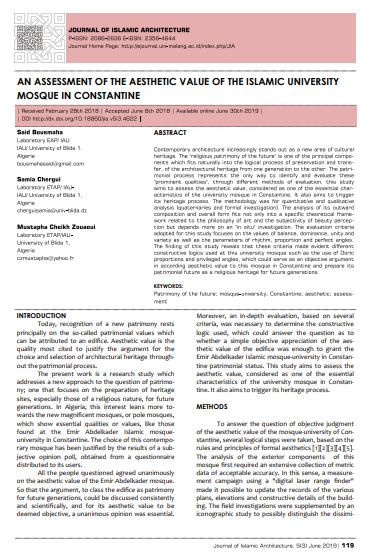
Contemporary architecture increasingly stands out as a new area of cultural heritage. The “religious patrimony of the future” is one of the principal components which fits naturally into the logical process of preservation and transfer, of the architectural heritage from one generation to the other. The patrimonial process represents the only way to identify and evaluate these “prominent qualities”, through different methods of evaluation. this study aims to assess the aesthetic value, considered as one of the essential characteristics of the university mosque in Constantine. It also aims to trigger its heritage process. The methodology was for quantitative and qualitative analysis (quaternaries and formal investigation). The analysis of its outward composition and overall form fits not only into a specific theoretical framework related to the philosophy of art and the subjectivity of beauty perception but depends more on an “in situ” investigation. The evaluation criteria adopted for this study focuses on the values of balance, dominance, unity and variety as well as the parameters of rhythm, proportion and perfect angles. The finding of this study reveals that these criteria made evident different constructive logics used at this university mosque such as the use of Doric proportions and privileged angles, which could serve as an objective argument in according aesthetic value to this mosque in Constantine and prepare its patrimonial future as a religious heritage for future generations.
I agree to the terms outlined below:
You agree to upload and assign Mosqpedia Database the rights to use the content worldwide and in perpetuity across all current and future media platforms. Mosqpedia Database may edit, copy, adapt and translate your contribution.
The content will be distributed under the Creative Commons Attribution-Deed – Attribution-NonCommercial-NoDerivatives 4.0 International – Creative Commons
All data will be stored in line with data protection regulations.